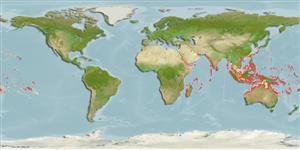Common names from other countries
Environment: milieu / climate zone / depth range / distribution range
Écologie
Récifal; profondeur 0 - 35 m (Ref. 8294). Tropical; 36°N - 26°S, 32°E - 119°W (Ref. 848)
Indo-Pacific: East Africa including Red Sea, to Polynesia, north to Japan and south to Australia.
Length at first maturity / Taille / Poids / Âge
Maturity: Lm ? range ? - ? cm Max length : 100.0 cm COLD mâle / non sexé; (Ref. 269)
Description synthétique
Morphologie
Formation: flat or hemispherical, mostly phaceloid with 1 to 3 centers per branch. Rarely over 0.5 m across, except in Red Sea. Calices: deep, with well defined walls. Septa: thick near the walls, thin within the calice. Tall and blunt septal teeth, size decreasing towards the columella. Color: greenish brown, gray, or mustard; usually pale centers (Ref. 848). This is one of the two species of Lobophyllia depicted here form distinctive hemispherical colonies up to 100 cm or more in diameter. In contrast to the following species the corallites of Lobophyllia corymbosa do not form long meanders but rather are mono- to tri-centric and often smaller in diameter (Ref. 269).
Minimum depth from Ref. 100938. Occurs in upper reef slopes (Ref. 848). Has high bleaching level and high estimated mortality in Palau (Ref. 66144).
Life cycle and mating behavior
Maturité | Reproduction | Frai | Œufs | Fécondité | Larves
Hermaphroditic (Ref. 113712). Mature gametes are shed into the coelenteron and spawned through the mouth. Life cycle: The zygote develops into a planktonic planula larva. Metamorphosis begins with early morphogenesis of tentacles, septa and pharynx before larval settlement on the aboral end (Ref. 833).
Hodgson, G. 1998. (Ref. 269)
Statut dans la liste rouge de l'IUCN (Ref. 130435)
statut CITES (Ref. 108899)
Not Evaluated
Utilisations par l'homme
| FishSource |
Outils
Sources Internet
Estimates based on models
Preferred temperature
(Ref.
115969): 25.1 - 29.3, mean 28.4 (based on 3306 cells).
Vulnérabilité
High vulnerability (60 of 100).
Catégorie de prix
Unknown.
